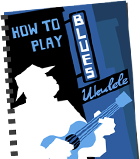I’m a huge fan of John King’s Classical Ukulele book (in an, “OMG!!!1! It changed the way I think about the ukulele,” way). So it was only a matter of time before I picked up his Famous Solos and Duets for ‘Ukulele as well.
The book contains tab and standard notation for 22 tunes (18 solo pieces, 2 ukulele duets and 2 ukulele/guitar duets) and comes with a CD of the tunes faultlessly performed. Most of them are Hawaiian tunes and, despite the cover proclaiming ‘arranged by John King’, many of the arrangements are by the original ukulele arrangers such as Ernest Ka’ai and N. B. Bailey
The full tab list is:
Loke Lani by Ernest Ka’ai Arr. by John King
Haele by Ernest Ka’ai
Hone A Ka Wai by Ernest Ka’ai
Polka-Mazurka by Ernest Ka’ai Arr. by Henry Kailimai
Ka Wehi by Ernest Ka’ai
Funiculi-Funicula by Luigi Denza Arr. by N. B. Bailey
Hene by Henry Kailimai
Ahi Wela by Arr. by Keoki E. Awai
Spanish Fandango by Henry Worrall Arr. by N. B. Bailey
The Blue Bells Of Scotland by Arr. by T. H. Rollinson
Leilani by Ernest Ka’ai
Banjo Schottische by Ernest K. Ka’ai
Lauia by Henry Kailimai Arr. by Ernest Ka’ai
Wailana by Malie Kaleikoa Arr. by Keoki E. Awai
The Good Stuff
Lovely Tunes: For the most part, the pieces are beautiful, lilting Hawaiian tunes. They’re pleasurable to play and repay attention to dynamics and touch – something that I’m definitely guilty of neglecting.
Strummed and Picked: There are quite a few strummed tunes in the book. And the strummed arrangements are just as much of a challenge as the picked tunes. They involve a whole load of tricky techniques which are explained in the introduction.
Range of Difficulty: While it’s not for beginners, there’s a good mix of difficultly in the tabs. Some, like Hene, you can have a reasonable stab at playing on sight. Others are very challenging.
Introduction: John King is probably the best writer on the history of the ukulele there’s ever been. The lack of his writing in Classical Ukulele is one of my few complaints I have about it. It’s not a complaint that could be made about this book. There’s a big chunk of ukulele history and ukulele tab history (a delight for me, but I’m the world’s biggest uke tab nerd) at the beginning and it’s a great read.
The Not So Good Stuff
Famous?: Despite spending a lot of time playing tunes from the book, there is a noticeable lack of people saying, “Hey, was that Hone A Ka Wai you were playing just then?” I must admit that before getting the book you could count the number of tunes in the book I could confidently hum on the fingers of one finger.
Duets: It’s a little light on the duets, if that’s what you’re looking for. As it happens, there are more duets in the Classical Ukulele book. Luckily, I have no friends anyway.
Tuning: The notation is for a C-tuned ukulele, yet the ukuleles on the recording switch between D-tuning and D#-tuning.
No Campanella – The arrangements are excellent. They sound great and are very playable. But the don’t have the distinctive harp-like sound of the arrangements in Classical Ukulele.
Overall
It’s probably not fair of me to keep comparing this to Classical Ukulele. I regard those arrangements as a work of genius.
This book is really a tribute to the original ukulele arrangers – Ernest Ka’ai in particular – and it has given me a whole new appreciation for those musicians who took the instrument and created new techniques and a new repertoire for it. Playing the pieces the way they played them gives me a more direct connection with its history than any amount of reading. Well worth the price of admission.
If you’ve got the book, let me know what you think in the comments.



I’m really fond of the “famous solos” book; in fact, it’s sitting in front of me right now. It took me a bit to realize that many of the arrangements are putting early 20th century material into modern format. (For some reason, I always dive straight into the tab, and skip the introduction.) Some of them are downright goofy, in a good way — an odd blend of Polynesian, Portuguese, and classical European musical influences. The “Banjo Schottische” is just a hoot!